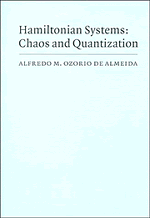3 - Chaotic motion
Published online by Cambridge University Press: 05 July 2011
Summary
The flow in an autonomous Hamiltonian system with one freedom is even more restricted than the generic motion categorized by Peixoto's theorem. The constancy of the Hamiltonian holds all the orbits to its level curves. For a bound system most of these will be closed loops, the exception being the levels of saddle points, that is, unstable equilibria of the Hamiltonian. The corresponding orbits either start out at an unstable point as t → - ∞ and return to the same point as t → + ∞, or go on to another unstable point. These two cases, known respectively as homoclinic and heteroclinic orbits, are shown in figs. 3.1a and b [under the potential curves V(q) that generate them, if the Hamiltonian has the form p2 + V(q)]. The homoclinic orbit of the pendulum (fig. 3.1b) is known as the separatrix between the small librations of the system and the full rotations arising at higher energies.
Consider making a small perturbation to this system, that is, coupling to another degree of freedom or, equivalently, adding an oscillatory forcing term to the Hamiltonian. Far from the unstable equilibrium, an orbit close to the separatrix will feel mainly the unperturbed Hamiltonian. But this gives a zero force near the saddle, so the perturbation becomes dominant near the unstable point: It can switch librations into rotations and back again. Successive switches will be uncorrelated, because the periods of rotations and librations lying close to the separatrix vary infinitely.
- Type
- Chapter
- Information
- Hamiltonian SystemsChaos and Quantization, pp. 48 - 73Publisher: Cambridge University PressPrint publication year: 1989



